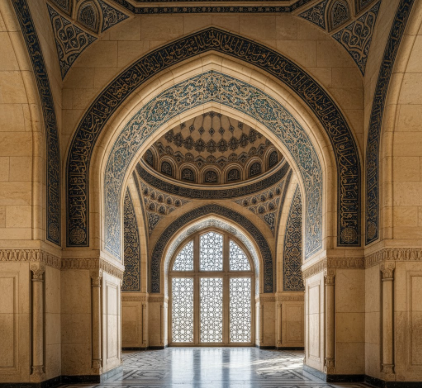Step into a world where mathematics sings and stone seems to defy gravity. Islamic architecture is not merely about building; it’s a profound expression of faith, art, and science woven together into structures that have captivated humanity for centuries. From the sun-drenched courtyards of Andalusia to the majestic domes of Istanbul, this architectural language speaks of infinity, order, and the sublime beauty of the divine. It invites you not just to look, but to feel a sense of tranquility and wonder, a feeling that you are standing at the threshold of something truly special.
Unlike many other architectural traditions that rely heavily on figurative art, Islamic design found its ultimate expression in abstraction. This wasn’t a limitation but a liberation, pushing artisans and architects to explore the boundless possibilities of geometry, calligraphy, and intricate patterns. The result is an architecture that engages the intellect as much as the eye, creating spaces that feel both intellectually rigorous and spiritually uplifting.
The Soul of the Structure: Core Principles
At the heart of Islamic architecture lies a deep sense of unity, or
Tawhid, the concept of the indivisible oneness of God. This principle is reflected in the harmonious integration of all parts of a building into a coherent whole. Every element, from the grandest dome to the smallest tile, is part of a larger, interconnected design. There’s a powerful sense of order and rhythm, a visual representation of the order of the cosmos. The patterns often radiate from a central point, expanding outwards in a way that suggests the infinite, reminding the viewer of the eternal and the transcendent.
Another key principle is the creation of a transitional space between the bustling outside world and a serene inner sanctuary. This is often achieved through courtyards (
sahn), gardens, and water features. These elements are not just decorative; they are functional and symbolic, creating a cool, peaceful environment for reflection and prayer—a metaphorical paradise on Earth.
Many of the intricate geometric patterns, known as girih, were created centuries before their mathematical principles were understood in the West. Researchers have discovered that by the 15th century, artisans were using a specific set of tiles to create complex, non-repeating patterns. These designs are now known as quasicrystalline patterns, a concept only formally described by modern mathematicians in the 1970s.
The Signature Elements of Design
While diverse across regions and dynasties, several distinct features define Islamic architecture, giving it a unique and instantly recognizable character.
Muqarnas: The Honeycomb of Heaven
Perhaps one of the most breathtaking and unique features is the
Muqarnas. This is a form of ornamented vaulting, a complex, three-dimensional structure composed of dozens or even hundreds of smaller, niche-like cells. Often described as “honeycomb” or “stalactite” vaulting, muqarnas are used to decorate domes, half-domes, and entranceways. They serve a dual purpose: structurally, they help transition from a square base to a circular dome, but their aesthetic effect is what truly mesmerizes. They capture and reflect light in a dazzling cascade, dematerializing the solidity of the stone and creating a sense of ethereal lightness, as if one is looking up into a celestial canopy.
Geometric Patterns: The Art of Infinity
The use of complex geometric patterns is a hallmark of Islamic art. These are not random decorations but are based on a grid of repeating circles and polygons that can be extended infinitely in all directions. This endless repetition is a direct reflection of the infinite nature of God. You can see this in the stunning tilework (
zellige) of Morocco, where hand-cut glazed tiles are pieced together in mesmerizing star-shaped and polygonal patterns, and in the carved stucco and woodwork that adorns walls and ceilings across the Islamic world.
Calligraphy: The Word Made Visible
Because of the aniconic (non-figurative) nature of religious art in Islam, calligraphy became one of the most important and revered art forms. The written word, specifically verses from the Qur’an, was elevated to a decorative art of immense beauty and spiritual significance. In architecture, calligraphy is used extensively, running in friezes along the tops of walls, encircling the base of domes, or framing grand portals. The flowing Kufic or elegant Thuluth scripts are not just inscriptions; they are integral parts of the architectural design, their graceful lines adding movement and spiritual weight to the structure.
Arches and Domes: Soaring Towards the Sky
The arch and the dome are central to the identity of Islamic architecture. While these forms existed in Roman and Byzantine structures, they were adapted and perfected in new ways. The
horseshoe arch, with its distinct, wide curve, became characteristic of Moorish architecture in Spain and North Africa. The
pointed arch, later adopted in European Gothic architecture, allowed for taller, more structurally stable buildings. Dominating the skyline, the dome represents the vault of heaven. Often decorated on the inside with intricate patterns or muqarnas, it creates a vast, unifying space beneath it, symbolic of the celestial sphere and the all-encompassing presence of the divine.









